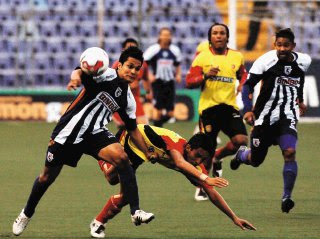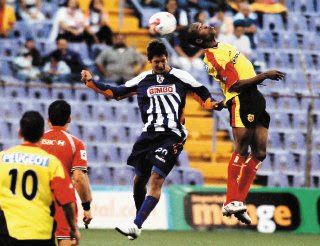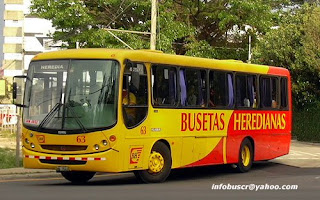

On Saturday, as it was Valentine's Day (
el día del amor y la amistad), and as Colin is such a romantic, he took Zoë out for a date... to the football!
A word of warning, if you have absolutely no interest in football you can probably stop reading here!
Ideally we would have been able to go and see our local team
C.S. Herediano (
English) play in their own little stadium. But as there hasn't been a suitable home game available we decided to take a trip to Tibas, a town/suburb just north of San Jose where Heredianos were away to
Saprissa (
English). At least this way we would get to see our home team and also get to visit
Costa Rica's largest stadium,
Estadio Ricardo Saprissa (
English), where Saprissa, and also currently the Costa Rican national team, play.
When you visit Costa Rica, and if you have any passing interest in football, you cannot fail to see or hear about the football team Saprissa. They are the Manchester United and Chelsea of Costa Rica. The richest and most successful team in the country and who it seems nearly every second person in the country supports as their "home" team. As you walk the streets of Heredia or San Jose, or in the malls and street markets you will always see at least one person in the purple of Saprissa. It is a shame that Saprissa are the Man U of Costa Rica, and therefore we can in no way bring ourselves to support them, because their purple and white strips are quite fetching it has to be said (although perhaps wearing a shirt with "
Bimbo", Saprissa's sponsor, across the front isn't smart in the UK).

We are not quite sure what the appeal is in supporting a team than nearly everyone else also supports (or at least it would appear that way). Saprissa do have one other team in the country that they are large rivals with, and that is
Liga Deportiva Alajuelense (
English). However, and this might just be in the areas we have visited, even this team seem to only have half the support of Saprissa. In the sports shops in malls and in towns, the only football shirts on sale are Saprissa, LDA and the Costa Rican national strip. Walking around we do occasionally see people wearing foreign football tops, these are only ever Barcelona, Real Madrid, Man Utd, Chelsea or Arsenal, no one else.
On approach to the stadium there were plenty of opportunities to purchase (mostly) Saprissa and (some) Heredia merchandise from the various street vendors that had set up stalls on street corners. Zoë was particularly attracted to the spiked furry hats with tails, but managed to resist. There were also one or two touts selling tickets. At the stadium itself there were quite large queues formed at the boleteria, but there was one window selling tickets to the
palco and platea which had a very small queue which we joined.
The stadium seats just over 23,000 people, so it was very similar in size to what we are used to with our own home stadium,
Pittodrie, home of
Aberdeen. However, Saprissa's stadium has two
very large covered stands on the east and west sides (along the touchlines of the field) and two smaller uncovered stands on the north and south (along the goal lines).

As it was a special occasion we purchased two palco tickets. These were the most expensive seats available and were for the boxes that were half way up the east and west stands. They were 8000 colones each (which is about £18 for both - you would struggle to get one cheap seat ticket in Scotland for that). On this occasion the tickets were not for specific numbered seats, so upon checking with a steward were were informed we could sit wherever we wanted. The palcos were really just sections of this part of the stand that were partially separated by wooden sides to their neighbours. There was no glass front or soft seats here, although some of the palcos must have been private or corporate as they were locked and had televisions. Each of the boxes held about 40 seats, and we picked one that was empty at the time (about 25 minutes before kick-off). At kick-off time though, it and most of the other boxes filled up quite a bit with men, women and children all present. The stadium looked about half full (so again similar to Pittodrie!) but the attendance probably wasn't helped by the fact that the game was on television. The only area of the stadium that looked particularly active/rowdy was in the South end (the sol sur) where the
Ultras and a brass band were located. This group of fans were continually jumping and seemed to be the only section that were singing any songs during the game.
That's not to say that our own section was completely quiet. In the front row of our palco was a male Saprissa fan who occasionally got quite animated and would allow us to hear some curses in Spanish. There were quite a lot of "hijo de puta" coming from him whenever a Saprissa forward missed another sitter.

It was also interesting to note that the few Heredia fans present were just dotted about all over the stadium, there was no one single area dedicated for them. Another difference was the fencing all around the pitch, something that hasn't been seen in the UK for a number of years. This did mean that no ball boys were situated around the field as the ball usually didn't make it over the fence when played out. The pitch at Saprissa is artifical turf and the ball did appear to bounce slightly more than on grass.
The game itself was quite entertaining, and the overall quality seemed very similar to that of an
SPL game. As you would expect of a latin american country, the individual skill and technical ability was present, but it did seem that the players would often try to beat one man too many and then lose the ball too often. Crosses of the ball were often good and many of the goal chances came from these or fast counter-attacks. The goalkeepers, like many in Europe nowadays, preferred to punch the ball out rather than attempt to catch it.
Saprissa are currently rated 122 in the
IFFHS World club rankings. As a comparison with Scottish teams, Glasgow Rangers and Celtic are 24 and 78 respectively and Aberdeen are currently rated 195.
Saprissa won the game 2-1, after Heredia had taken a 1-0 lead. Despite Saprissa dominating much of the game, they were helped by some dubious refereeing decisions including the award of a penalty and subsequent sending off of a Heredia player (
Mauricio Solis). After this decision and the penalty it took about 5 minutes for the game to restart and the Heredia players to stop surrounding the dodgy ref. At the end of the game the ref was again surrounded (after he blew the final whistle while Heredia were about to take a corner) and we read later about the Heredia coach,
Paulo Wanchope a name familiar to British football fans, complaining that his team had to
play against 12 players (including the ref).

It took a long time for us to catch a bus back to Heredia as the queue was long and numerous full buses passed without stopping. But despite there being both Saprissa and Heredia fans in the queue everyone was in reasonably high spirits after a pretty good evening's entertainment.

Match photos from
La Nacion.











